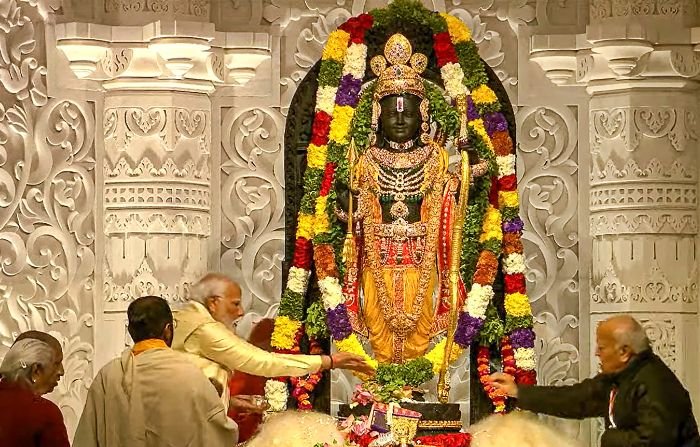On January 22, 2024, Indian Prime Minister Narendra Modi led the consecration of a grand Ram temple in Ayodhya to the Hindu god Lord Ram on a site that has been a source of tension between Hindus and Muslims for decades. The new $300 million temple is located in Ayodhya, a city in the northern state of Uttar Pradesh, and is built on the site where a mosque was destroyed by Hindu extremists in 1992, sparking deadly riots across India.
The consecration ceremony
The consecration ceremony, known as “pran pratishtha,” began at noon and lasted for about an hour. During the ceremony, the new Ram Lalla idol was consecrated at the 161-feet tall pink sandstone shrine, which was carved by Mysuru-based sculptor Arun Yogiraj. The idol was placed in the sanctum sanctorum of the Ram Janmabhoomi, the birthplace of Lord Ram.The ceremony was attended by about 7,000 distinguished guests, including Uttar Pradesh Chief Minister Yogi Adityanath and various saints. Indian Air Force (IAF) choppers showered vibrant flower petals over the temple grounds, and Prime Minister Modi, along with other dignitaries, offered heartfelt prayers to Ram Lalla.
Modi’s speech
In his speech at the ceremony, Modi remembered all the “kar sevaks” who sacrificed their lives, which ultimately led to the consecration of the Ram temple in after centuries of struggle. He also declared January 22, 2024, as the origin of a new era.”The whole of today, our Ram has come!” Modi said in an emotional speech. “January 22, 2024, is not a date written on the calendar. This is the origin of a new era.”Modi also expressed his gratitude to the judiciary of India for doing justice and said that the construction of the temple was a symbol of India’s unity in diversity.
Background
The dispute over the site Ram temple in Ayodhya dates back to the 16th century when a mosque was built on the site by Mughal emperor Babur. In 1992, Hindu extremists destroyed the mosque, claiming that it was built on the birthplace of Lord Ram. The incident sparked deadly riots across India, and the site has been a source of tension between Hindus and Muslims ever since.In November 2019, the Supreme Court of India ruled that the site should be handed over to a trust to build a temple to Lord Ram, while Muslims should be given an alternative site to build a mosque. The court’s decision was widely welcomed by Hindus, but it was criticized by Muslims and secularists who saw it as a blow to India’s secular fabric.
Conclusion
The consecration of the grand Ram temple in Ayodhya is a significant event in India’s history, marking the end of a decades-long dispute over the site. The construction of the temple is seen as a victory for Hindu nationalists and a symbol of India’s Hindu identity. However, it has also raised concerns about the marginalization of India’s Muslim minority and the erosion of India’s secular fabric.



